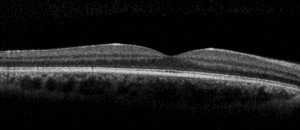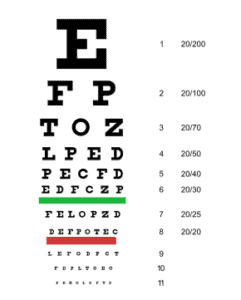
The ABCs of Eyes
October 30, 2021

Over the last three years, we have been sharing blog posts with the goal of educating our patients and the general public. Understanding the fundamentals of eye health leads to an increased awareness and desire to prioritize our one and only set of eyes. To celebrate our 100th post, here is a summary of our favorite blog topics. Clicking the topic will direct you to the original blog entry.

A – ALLERGIES
Itchy, red, burning eyes flare up for most people during the spring and fall allergy seasons. While avoiding the allergen is the best way to prevent allergy symptoms, it can be unavoidable in some cases. Over-the-counter antihistamine/mast cell stabilizer combination eye drops are the treatment of choice. Just remember – rubbing your eyes makes the symptoms worse!
B – BLINDNESS
According to the CDC, the leading causes of blindness include age-related macular degeneration, diabetic retinopathy, and glaucoma. In the United States, one of the following criteria needs to be met in order to be considered legally blind: 1) Visual acuity must be 20/200 or worse in the better seeing eye with correction. 2) The visual field is a total of 20 degrees or less. Low vision resources are available for those with permanent vision loss.
C – CATARACTS
The most common, age-related, form of cataracts is called nuclear sclerosis, which literally translates to “hardening of the nucleus” (centermost part of the lens). As cataracts get worse, blurred vision and glare become problematic and may hinder everyday activities. Fortunately, cataract surgery is accessible in the United States, and greatly improves vision. Although we can try to delay the onset and progression of cataracts, there is nothing we can do to completely avoid the presence of age-related cataracts.
D – DIABETES
Diabetes is elevated blood glucose, or sugar in the blood. An excessive amount of sugar in the blood makes the blood vessels weak and leak blood. The tiny blood vessels in the retina are very vulnerable to these changes and can cause serious visual complications if not controlled. The most important aspect of treating diabetic retinopathy is decreasing the blood sugar to minimize the risk of further (and possibly permanent) vision problems.
Eyebrows function to channel liquids (water, sweat, chemicals) away from the eyes. Similarly, lashes protect the eyes from foreign objects falling or blowing into the eyes. Eyelashes are also helpful for reflexive blinking if a little bug is flying towards the eye. In general, it is important to clean the eyelids and lashes to decrease the risk of infection and inflammation.
F – FLOATERS
Floaters are visualized as a shadow of vitreous fibers that have separated from the vitreous bulk (gel-like substance inside the eye). The common description is black or gray dots, strands, or cobweb-like images that move when the eye moves. Over time, the brain can slowly start to ignore the floaters, which makes them less annoying. While most floaters are a harmless age-related change, other floaters can be an indication of a retina problem.
G – GLAUCOMA
Glaucoma is a chronic, progressive condition that causes damage to the optic nerve. This is usually associated with increased eye pressure, but it is possible to have normal eye pressure and still develop glaucoma damage. There are little to no symptoms, which makes it nearly impossible to diagnose without an eye exam. Once diagnosed, the most common treatment is a prescription eye drop to lower the eye pressure.
H – HORDEOLUM
A hordeolum, or stye, is most commonly caused by a blocked oil gland along the eyelid margin that becomes infected. The first symptom is usually focal eyelid tenderness, and there may be a red bump along the eyelid. The best way to get rid of a stye is to use frequent warm compresses to melt the oil in the clogged gland.
I – IRIS COLOR
The iris is the colored part of the eye that surrounds the pupil and controls how much light enters the eye. When in a dark or dim environment, the iris muscles constrict, and the pupil enlarges (or dilates), allowing more light to enter into the eye. If the setting is bright, the iris width increases, which makes the pupil smaller. Beyond its biological function, the iris can be used as a security feature on electronics due to its unique, fingerprint-like properties.

We’re sure you are all wondering how our dear Jane has been doing celebrating retirement since the end of 2018. She looks better than ever! It must be all the time she is able to spend with her dog, Missy. Jane also enjoys being on her iPad. (Who would have thought Jane would continue learning about electronics after her big transition to computers here?!) We miss you, Jane!
K – KERATOCONUS
Keratoconus is a condition of the cornea (front surface of eye) that causes progressive corneal thinning and bulging into a cone-shape. As keratoconus worsens, blurry or distorted vision is the primary symptom. Glasses and soft contact lenses are the first method of treating the blurry vision, however, some individuals need to be fit with specialty rigid gas permeable or scleral contact lenses.
L – LINDBERG
LINDBERG is a luxurious eyewear brand from Denmark that we are proud to display in our optical. The frames weigh as little as 1.9 grams, yet maintain extreme durability and flexibility. The frame shape, materials, and colors are customizable and create a one-of-a-kind pair of glasses. Complementary name engraving on the inside of the frame is a reminder of the personal touch that went into creating your featherweight accessory.
Age-related macular degeneration (AMD) is the leading cause of vision loss in those 50 years and older. As the name implies, macular degeneration is degeneration of the macula, which is the part of the retina responsible for central vision. The two types of AMD are dry and wet. The wet form can be treated with eye injections, however, it still tends to cause more permanent vision loss than the dry form with no available treatments.
N – NEARSIGHTEDNESS
If a person can see up close, but cannot see clearly in the distance, they are considered nearsighted. Another term for nearsightedness is called myopia. Glasses and contact lenses are used to improve distance vision associated with nearsightedness. Also, LASIK is a refractive surgery that corrects nearsightedness by flattening or reshaping the cornea with a laser.
O – OCT
Optical coherence tomography (OCT) is an important instrument used to diagnose and monitor changes in those with retinal conditions, such as macular degeneration, glaucoma, and diabetic retinopathy. It provides detailed cross-sections and three-dimensional mapping of the retina and optic nerve. The iWellness scan uses OCT technology as a screening tool for early diagnosis of the previously mentioned conditions (and more!).
P – PRESBYOPIA
Presbyopia is a natural process than begins around age 40 and results in the inability to see small print up close. Eventually, the use of progressive lenses, bifocals, reading glasses, or multifocal contact lenses becomes necessary. If a person is nearsighted, removing distance glasses will improve the reading up close; however, this can be disruptive to constantly be putting glasses on and off.
Q – Q&A
In the Q&A blog post, you’ll find answers to questions such as: “Will wearing glasses make my vision worse? When should my child have their first eye exam? Can I wear contacts if I have astigmatism?” If you have stayed up to date with reading the Weber Vision Care blog, you should know the answers to all of these questions already!
When a person experiences a retinal detachment, the retina separates from the back of the eye, which contains the necessary supply of nutrients and connections to the brain for processing vision. There is no pain associated with a retinal detachment, so it is important to look out for the following symptoms: sudden or worsening of floaters, flashes of light in vision, curtain-like shadow moving across vision, or blurred vision. Prompt treatment is necessary to minimize permanent vision loss.
S – STRABISMUS
Strabismus is misalignment of the eyes due to ocular muscle imbalance. If strabismus occurs later in life, it usually results in double vision. When a child develops strabismus, it can lead to strabismic amblyopia (more commonly known as a “lazy eye”) because the connection between the eye and the brain is no longer developing as well as the other eye. Prescription glasses, prism, and vision therapy are the first line of treatment for strabismus, however, surgery may be necessary in severe cases.
T – TERRACYCLE
TerraCycle® is a recycling program that aims to minimize waste by recycling what once could not be recycled – such as empty contact lens blister packs and used contacts. The Bausch + Lomb ONE by ONE Recycling Program has partnered with TerraCycle to promote this effort in optometry practices around the country. For every qualifying shipment, a $1/lb donation is made to Optometry Giving Sight, a nonprofit organization that provides eye exams and glasses to those without access to care. Weber Vision Care is a participating office, and we will ship your recyclables for you!
U – UVEITIS
Uveitis is inflammation or swelling of the uvea, which is the middle layer of the eye. There are many different causes of uveitis, and in some cases, a particular cause is not always determined. The main symptoms of uveitis include photophobia (light sensitivity), eye pain, blurry vision, and floaters. Steroid eye drops are typically used to treat the ocular inflammation, and any contributing systemic conditions need to be treated as well.
V – VISION SCREENING
A vision screening at school or the pediatrician’s office is not a substitute for a comprehensive eye exam. Just as the name implies, a vision screening is simply a quick check of vision to determine if there is a big issue. Most vision problems are more subtle than a screening can detect, and eye health is not even addressed. The American Optometric Association recommends the first eye exam between the ages of 6 to 12 months, then at 3 years old, 5 years old, and every year through school.
It is very important to wear sunglasses during the winter because snow reflects more harmful UV rays than grass, pavement, and water. Invisible UV rays can cause damage to eyes by expediting the formation of cataracts, playing a role in the development of macular degeneration, and causing photokeratitis (corneal sunburn). Sunglasses not only provide UV protection, but they are also a barrier to protect the eyes against cold, dry air in the winter.
X – XANTHELASMA
Xanthelasma (zan-thuh-lahz-muh) is an abnormal pocket of fat located just underneath the skin adjacent to the eyelids. It appears as a mildly raised, yellow lesion around the inner part of the eyelids towards the nose. Xanthelasma is commonly seen in someone with high cholesterol, and can be cosmetically unpleasing for some individuals.
Y – YAG CAPSULOTOMY
After cataract surgery, about one-third of people develop posterior capsular opacification, or clouding of the back capsule that holds the lens implant in place. If the capsule becomes too cloudy, vision will be blurry. A YAG capsulotomy is a laser procedure to remove a portion of the cloudy membrane, which restores vision back to its original clarity after cataract surgery.
Z – ZEAXANTHIN
Zeaxanthin is an important ingredient in the AREDS 2 formulation of eye vitamins for macular degeneration. It can also be found in dark green vegetables, such as collard greens, spinach, and green beans. The Age-Related Eye Disease Study (AREDS) found that a specific combination of vitamins and minerals can aid in slowing the progression of macular degeneration.
“Now I know my ABCs. Next time won’t you sing with me!”